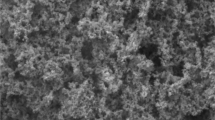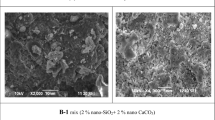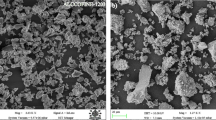Abstract
Introduction
Although the use of Colloidal Nanosilica (CNS) has shown significant advantages on strength and durability development of cement composites. However, the impact of CNS with Metakaolin (MK) has not been established well.
Objective
This study presents a novel amalgamation of nano and micro-sized supplementary cementing materials in cement composites. The rationale behind this was to study their effects on strength and durability properties. Besides this, the microstructural investigation was carried out using FESEM and XRD to explore the underlying mechanisms.
Methods
Before casting, the workability of concrete were tested. The mechanical and durability properties including compressive strength, splitting tensile strength, flexural strength, Rapid chloride permeability tests, water absorption, sulfate, and acid attack resistance tests were carried out. Furthermore, besides strength and durability studies, an extensive microstructural investigation was carried under FESEM and XRD to explore the underlying mechanisms.
Results
Twenty different concrete mixtures were designed and explored. The results indicate that the incorporation of CNS and MK in cement composites has increased the admixture demand. The strength of all mixtures increased at various curing ages up to 90 days compared to normal concrete. The maximum increase in strength parameters at 0.44 w/b ratio was observed at 0.45% CNS and 10% MK content. The durability parameters studied like water absorption and RCPT showed an increase in resistance to permeability. Which indicated less porosity of modified mixtures. In acid and sulfate attacks, the normal concrete showed the poorest performance, and CNS and MK enabled some resistance to sulphuric acid and sulfate attack at 120 days. The microstructural characterization conducted during this study has shown that the replacement of cement by MK and CNS has improved the microstructure compared to normal concrete.
Conclusion
The simultaneous incorporation of MK and CNS has reduced workability. In terms of mechanical strength, it is observed that the optimum amount of CNS and MK was 0.45% and 10% respectively. Also, the MK and CNS addition has decreased the water absorption, increased resistance to chloride ion permeability, acid, and sulfate attack compared to normal concrete.












Similar content being viewed by others
References
Madlool NA, Saidur R, Hossain MS, Rahim NA (2011) A critical review on energy use and savings in the cement industries. Renew Sustain Energy Rev 15(4):2042–2060. https://doi.org/10.1016/j.rser.2011.01.005
Schneider M, Romer M, Tschudin M, Bolio H (2011) Sustainable cement production-present and future. Cem Concr Res 41(7):642–650. https://doi.org/10.1016/j.cemconres.2011.03.019
Hemalatha T, Ramaswamy A (2017) A review on fly ash characteristics—towards promoting high volume utilization in developing sustainable concrete. J Clean Prod 147:546–559. https://doi.org/10.1016/j.jclepro.2017.01.114
Oner A, Akyuz S (2007) An experimental study on optimum usage of GGBS for the compressive strength of concrete. Cem Concr Compos 29(6):505–514. https://doi.org/10.1016/j.cemconcomp.2007.01.001
Fapohunda C, Akinbile B, Shittu A (2017) Structure and properties of mortar and concrete with rice husk ash as partial replacement of ordinary Portland cement—a review. Int J Sustain Built Environ 6(2):675–692. https://doi.org/10.1016/j.ijsbe.2017.07.004
Moodi F, Ramezanianpour AA, Safavizadeh AS (2011) Evaluation of the optimal process of thermal activation of kaolins. Sci Iran 18(4A):906–912. https://doi.org/10.1016/j.scient.2011.07.011
Dinakar P, Sahoo PK, Sriram G (2013) Effect of metakaolin content on the properties of high strength concrete. Int J Concr Struct Mater 7(3):215–223. https://doi.org/10.1007/s40069-013-0045-0
Glavind M (2009) Sustainability of cement, concrete and cement replacement materials in construction. Sustainability of construction materials. Woodhead Publishing Limited, Sawston, pp 120–147
Ilić BR, Mitrović AA, Miličić LR (2010) Thermal treatment of kaolin clay to obtain metakaolin. Hem Ind 64(4):351–356. https://doi.org/10.2298/HEMIND100322014I
Sabir B, Wild S, Bai J (2001) Metakaolin and calcined clays as pozzolans for concrete: a review. Cem Concr Compos 23(6):441–454. https://doi.org/10.1016/S0958-9465(00)00092-5
J. A. Kostuch, M. R. Jones, T. R. Jones (1993) “High performance concretes incorporating metakaolin: a review.” In: International conference pp. 1799–1812.
Cyr M, Trinh M, Husson B, Casaux-Ginestet G (2014) Effect of cement type on metakaolin efficiency. Cem Concr Res 64:63–72. https://doi.org/10.1016/j.cemconres.2014.06.007
Said-mansour M, Kadri E, Kenai S, Ghrici M, Bennaceur R (2011) Influence of calcined kaolin on mortar properties. Constr Build Mater 25(5):2275–2282. https://doi.org/10.1016/j.conbuildmat.2010.11.017
Wild S, Khatib JM, Jones A (1996) Relative strength, pozzolanic activity and cement hydration in superplasticised metakaolin concrete. Cem Concr Res 26(10):1537–1544. https://doi.org/10.1016/0008-8846(96)00148-2
Poon CS, Lam L, Kou SC, Wong YL, Wong R (2001) Rate of pozzolanic reaction of metakaolin in high-performance cement pastes. Cem Concr Res 31(9):1301–1306. https://doi.org/10.1016/S0008-8846(01)00581-6
Sanchez F, Sobolev K (2010) Nanotechnology in concrete—a review. Constr Build Mater 24(11):2060–2071. https://doi.org/10.1016/j.conbuildmat.2010.03.014
Balapour M, Joshaghani A, Althoey F (2018) Nano-SiO2 contribution to mechanical, durability, fresh and microstructural characteristics of concrete: a review. Constr Build Mater 181:27–41. https://doi.org/10.1016/j.conbuildmat.2018.05.266
Norhasri MSSM, Hamidah MS, Fadzil AM (2017) Applications of using nano material in concrete: a review. Constr Build Mater 133:91–97. https://doi.org/10.1016/j.conbuildmat.2016.12.005
Shaikh FUA, Supit SWM, Sarker PK (2014) A study on the effect of nano silica on compressive strength of high volume fly ash mortars and concretes. Mater Des 60:433–442. https://doi.org/10.1016/j.matdes.2014.04.025
Isfahani FT, Redaelli E, Lollini F, Li W, Bertolini L (2016) Effects of nanosilica on compressive strength and durability properties of concrete with different water to binder ratios. Adv Mater Sci Eng. https://doi.org/10.1155/2016/8453567
Cai Y, Hou P, Cheng X, Du P, Ye Z (2017) The effects of nanoSiO2 on the properties of fresh and hardened cement-based materials through its dispersion with silica fume. Constr Build Mater 148:770–780. https://doi.org/10.1016/j.conbuildmat.2017.05.091
Du H, Du S, Liu X (2014) Durability performances of concrete with nano-silica. Constr Build Mater 73:705–712. https://doi.org/10.1016/j.conbuildmat.2014.10.014
Ji T (2005) Preliminary study on the water permeability and microstructure of concrete incorporating nano-SiO 2. Cement Concr Res 35:1943–1947. https://doi.org/10.1016/j.cemconres.2005.07.004
Zhang MH, Li H (2011) Pore structure and chloride permeability of concrete containing nano-particles for pavement. Constr Build Mater 25(2):608–616. https://doi.org/10.1016/j.conbuildmat.2010.07.032
Naji Givi A, Abdul Rashid S, Aziz FNA, Salleh MAM (2010) Experimental investigation of the size effects of SiO2 nano-particles on the mechanical properties of binary blended concrete. Compos B Eng 41(8):673–677. https://doi.org/10.1016/j.compositesb.2010.08.003
Hou P, Kawashima S, Kong D, Corr DJ, Qian J, Shah SP (2013) Modification effects of colloidal nanoSiO2 on cement hydration and its gel property. Compos B Eng 45(1):440–448. https://doi.org/10.1016/j.compositesb.2012.05.056
Luo Z, Li W, Li P, Wang K, Shah SP (2021) Investigation on effect of nanosilica dispersion on the properties and microstructures of fly ash-based geopolymer composite. Constr Build Mater 282:122690. https://doi.org/10.1016/j.conbuildmat.2021.122690
Quercia G, Hüsken G, Brouwers HJH (2012) Cement and concrete research water demand of amorphous nano silica and its impact on the workability of cement paste. Cem Concr Res 42(2):344–357. https://doi.org/10.1016/j.cemconres.2011.10.008
Shih J, Chang T, Hsiao T (2005) Effect of nanosilica on characterization of Portland cement composite. Mater Sci Eng A 424:266–274. https://doi.org/10.1016/j.msea.2006.03.010
BIS (2013) IS 8112-2013: Ordinary Portland cement, 43 grade-specification
Indian Standard IS 2720 (Part 3) (1980) Methods of test for soils, determination of specific gravity, fine, medium and coarse grained soils, New Delhi
BIS (1998) IS: 4031 (4): Methods of physical tests for hydraulic cement. Part 4: Determination of consistency of standard cement paste
BIS (Bureau of Indian Standards) (1988) IS: 4031 (3) Methods of physical tests for hydraulic cement, part 3: determination of soundness
BIS (1988) IS 4031 (5): Methods of physical tests for hydraulic cement. Part-5: Determination of initial and final setting times
BIS (1989) IS: 4031 (6): Methods of physical tests for hydraulic cement. Part 6: Determination of compressive strength of hydraulic cement other than masonry cement
BIS, I. 10262–2019 (2019) Specification for mix design guidelines for concrete. Bureau of Indian Standards, New Delhi
BIS, I. (1959) IS 1199-1959. Methods of Sampling and Analysis of Concrete, Bureau of Indian Standards, New Delhi, India
BIS 516 (2004) IS 516-1959: Method of tests for strength of concrete
BIS, I. (1999) 5816–1999. Specification for Splitting Tensile strength of Concrete–Method of Test, Bureau of Indian Standards, New Delhi, India
AMERICAN SOCIETY FOR TESTING AND MATERIALS (ASTM) (2012) Standard test method for electrical indication of concrete's ability to resist chloride ion penetration. ASTM C-1202. Annual book of ASTM Standards
Bai J, Wild S, Sabir BB, Kinuthia JM (1999) Workability of concrete incorporating pulverized fuel ash and metakaolin. Mag Concr Res 51(3):207–216. https://doi.org/10.1680/macr.1999.51.3.207
Lenka S, Panda KC (2017) Effect of metakaolin on the properties of conventional and self compacting concrete. Adv Concr Constr 5(1):31–48. https://doi.org/10.12989/acc.2017.5.1.31
Yu R, Spiesz P, Brouwers HJH (2014) Effect of nano-silica on the hydration and microstructure development of ultra-high performance concrete (UHPC) with a low binder amount. Constr Build Mater 65:140–150. https://doi.org/10.1016/j.conbuildmat.2014.04.063
Chong JZ, Sutan NM, Yakub I (2013) Characterization of early pozzolanic reaction of calcium hydroxide and calcium silicate hydrate for nanosilica modified cement paste. J Civ Eng Sci Technol 4(3):6–10. https://doi.org/10.33736/jcest.120.2013
Janotka I, Puertas F, Palacios M, Kuliffayová M, Varga C (2010) Metakaolin sand—blended-cement pastes: rheology, hydration process and mechanical properties. Constr Build Mater 24(5):791–802. https://doi.org/10.1016/j.conbuildmat.2009.10.028
Duan P, Shui Z, Chen W, Shen C (2013) Effects of metakaolin, silica fume and slag on pore structure, interfacial transition zone and compressive strength of concrete. Constr Build Mater 44:1–6. https://doi.org/10.1016/j.conbuildmat.2013.02.075
Zahedi M, Ramezanianpour AA, Ramezanianpour AM (2015) Evaluation of the mechanical properties and durability of cement mortars containing nanosilica and rice husk ash under chloride ion penetration. Constr Build Mater 78:354–361. https://doi.org/10.1016/j.conbuildmat.2015.01.045
Khatib JM (2008) Metakaolin concrete at a low water to binder ratio. Constr Build Mater 22(8):1691–1700. https://doi.org/10.1016/j.conbuildmat.2007.06.003
Uddin F, Shaikh A, Hosan A (2019) Effect of nano silica on compressive strength and microstructures of high volume blast furnace slag and high volume blast furnace slag- fl y ash blended pastes. Sustain Mater Technol 17:e00111. https://doi.org/10.1016/j.susmat.2019.e00111
Ding JT, Li Z (2002) Effects of metakaolin and silica fume on properties of concrete. ACI Mater J 99(4):393–398. https://doi.org/10.14359/12222
Pul S (2008) Experimental investigation of tensile behaviour of high strength concrete. Indian J Eng Mater Sci 15(6):467–472
Raphael JM (1984) Tensile strength of concrete. J Am Concr Inst 81(2):158–165. https://doi.org/10.1007/978-3-642-41714-6_200519
Carrasquillo RL, Nilson AH, Slate FO (1981) Properties of high strength concrete subject to short-term loads. J Am Concr Inst 78(3):171–178. https://doi.org/10.14359/6914
Ahmed M, El Hadi KM, Hasan MA, Mallick J, Ahmed A (2014) Evaluating the co-relationship between concrete flexural tensile strength and compressive strength. Int J Struct Eng 5(2):115–131. https://doi.org/10.1504/IJSTRUCTE.2014.060902
ACI committee 318 (2011) Building code requirements for structural concrete and commentary (ACI 318M–11). American Concrete Institute, Farmington Hills
Indian Standard (2000) Plain and reinforced concrete-code of practice. New Delhi: Bureau of Indian Standards
Kirkbridge TW (1997) Structural use of concrete—part 1: code of practice for design and construction
Concrete structures standard (2006) NZS 3101: 2006. Standards Association, Wellington, NZ
Singh LP, Goel A, Bhattachharyya SK, Ahalawat S, Sharma U, Mishra G (2015) Effect of morphology and dispersibility of silica nanoparticles on the mechanical behaviour of cement mortar. Int J Concr Struct Mater 9(2):207–217. https://doi.org/10.1007/s40069-015-0099-2
Nas M, Kurbetci S (2018) Durability properties of concrete containing metakaolin. Adv Concr Constr 6(2):159–175. https://doi.org/10.12989/acc.2018.6.2.159
Dhinakaran G, Thilgavathi S, Venkataramana J (2012) Compressive strength and chloride resistance of metakaolin concrete. KSCE J Civ Eng 16(7):1209–1217. https://doi.org/10.1007/s12205-012-1235-z
Talero R (2012) Synergic effect of Friedel’s salt from pozzolan and from OPC co-precipitating in a chloride solution. Constr Build Mater 33:164–180. https://doi.org/10.1016/j.conbuildmat.2011.12.040
Farnam Y, Wiese A, Bentz D, Davis J, Weiss J (2015) Damage development in cementitious materials exposed to magnesium chloride deicing salt. Constr Build Mater 93:384–392. https://doi.org/10.1016/j.conbuildmat.2015.06.004
Qiao C, Suraneni P, Weiss J (2018) Damage in cement pastes exposed to NaCl solutions. Constr Build Mater 171:120–127. https://doi.org/10.1016/j.conbuildmat.2018.03.123
Du H, Du S, Liu X (2014) Durability performances of concrete with nano-silica. Constr Build Mater 73(December):705–712. https://doi.org/10.1016/j.conbuildmat.2014.10.014
Güneyisi E, Özturan T (2012) Strength development of concretes incorporated with metakaolin and different types of calcined kaolins. Constr Build Mater 37:766–774. https://doi.org/10.1016/j.conbuildmat.2012.07.077
Madandoust R, Mousavi SY (2012) Fresh and hardened properties of self-compacting concrete containing metakaolin. Constr Build Mater 35:752–760. https://doi.org/10.1016/j.conbuildmat.2012.04.109
Karaog S, Mermerdas K, Güneyisi E, Gesog M (2012) Strength, permeability and shrinkage cracking of silica fume and metakaolin concretes. Constr Build Mater 34:120–130. https://doi.org/10.1016/j.conbuildmat.2012.02.017
Wild S, Khatib JM (1997) Pergamon PI1 SOOOS-8846(96)00187-l Portlandite consumption in metakaolin cement pastes and mortars. Cem End Concr Res 27(1):137–146
Beulah, Prahallada MC (2012) Effect of replacement of cement by metakalion on the properties of high performance concrete subjected to acid attack. i-manager’s J Civ Eng 2(3):14–21. https://doi.org/10.2634/jce.2.3.1934
Al-Akhras NM (2006) Durability of metakaolin concrete to sulfate attack. Cem Concr Res 36(9):1727–1734. https://doi.org/10.1016/j.cemconres.2006.03.026
Khatib JM, Wild S (1998) Sulphate resistance of metakaolin mortar. Cem Concr Res 28(1):83–92. https://doi.org/10.1016/S0008-8846(97)00210-X
Khatib JM, Hibbert JJ (2005) Selected engineering properties of concrete incorporating slag and metakaolin. Constr Build Mater 19(6):460–472. https://doi.org/10.1016/j.conbuildmat.2004.07.017
Madani H, Bagheri A, Parhizkar T (2012) The pozzolanic reactivity of monodispersed nanosilica hydrosols and their influence on the hydration characteristics of Portland cement. Cem Concr Res 42(12):1563–1570. https://doi.org/10.1016/j.cemconres.2012.09.004
Samimi K, Shirzadi Javid AA (2021) Magnesium sulfate (MgSO4) attack and chloride isothermal effects on the self-consolidating concrete containing metakaolin and zeolite. Iran J Sci Technol Trans Civ Eng 45(1):165–180. https://doi.org/10.1007/s40996-020-00398-6
Ramlochan T, Thomas M (2000) Effect of metakaolin on external sulfate attack. American Concrete Institute, ACI Special Publication, SP-192, pp 239–251. https://doi.org/10.14359/5752
Al-Akhras NM (2006) Durability of metakaolin concrete to sulfate attack. Cem Concr Res 36(9):1727–1734. https://doi.org/10.1016/j.cemconres.2006.03.026
Ghafari E, Arezoumandi M, Costa H, Júlio E (2015) Influence of nano-silica addition on durability of UHPC. Constr Build Mater 94:181–188. https://doi.org/10.1016/j.conbuildmat.2015.07.009
Qin Z, Ma C, Zheng Z, Long G, Chen B (2020) Effects of metakaolin on properties and microstructure of magnesium phosphate cement. Constr Build Mater 234:117353. https://doi.org/10.1016/j.conbuildmat.2019.117353
Ramezanianpour AA, Jovein HB (2012) Influence of metakaolin as supplementary cementing material on strength and durability of concretes. Constr Build Mater 30:470–479. https://doi.org/10.1016/j.conbuildmat.2011.12.050
Dinakar P, Sahoo PK, Sriram G (2013) Effect of metakaolin content on the properties of high strength concrete. Int J Concr Struct Mater 7(3):215–223. https://doi.org/10.1007/s40069-013-0045-0
Barbhuiya S, Chow P, Memon S (2015) Microstructure, hydration and nanomechanical properties of concrete containing metakaolin. Constr Build Mater 95:696–702. https://doi.org/10.1016/j.conbuildmat.2015.07.101
Kadri EH, Kenai S, Ezziane K, Siddique R, De Schutter G (2011) Influence of metakaolin and silica fume on the heat of hydration and compressive strength development of mortar. Appl Clay Sci 53(4):704–708. https://doi.org/10.1016/j.clay.2011.06.008
Acknowledgements
Authors are highly grateful and appreciate the Ministry of Human Resource Development's funding support and are thankful to National Institute of Technology for providing the laboratory facilities during this research work.
Funding
This study was supported by Ministry of Human Resource Development.
Author information
Authors and Affiliations
Contributions
AHB: conceptualization, methodology, experimental investigation, writing. JAN: review and editing.
Corresponding author
Ethics declarations
Conflict of interest
The authors declare that they have no conflict of interest.
Additional information
Publisher's Note
Springer Nature remains neutral with regard to jurisdictional claims in published maps and institutional affiliations.
Rights and permissions
About this article
Cite this article
Bhat, A.H., Naqash, J.A. Experimental studies of sustainable concrete modified with colloidal nanosilica and metakaolin. J Build Rehabil 7, 18 (2022). https://doi.org/10.1007/s41024-021-00157-8
Received:
Revised:
Accepted:
Published:
DOI: https://doi.org/10.1007/s41024-021-00157-8




